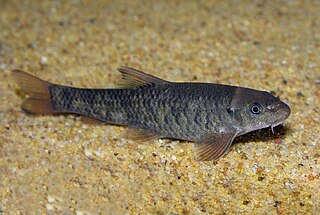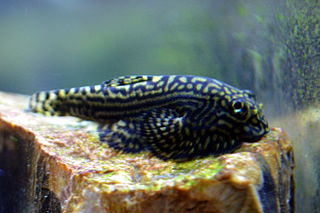
Cobitis is a genus of small freshwater fish in the family Cobitidae from temperate and subtropical Eurasia. It contains the "typical spiny loaches", including the well-known spined loach of Europe. Similar spiny loaches, occurring generally south of the range of Cobitis, are nowadays separated in Sabanejewia.

Garra is a genus of fish in the family Cyprinidae. These fish are one example of the "log suckers", sucker-mouthed barbs and other cyprinids commonly kept in aquaria to keep down algae. The doctor fish of Anatolia and the Middle East belongs in this genus. The majority of the more than 160 species of garras are native to Asia, but about one-fifth of the species are from Africa.
The eastern crested loach is a species of stone loach native to Central Asia. This species grows to a length of 20 centimetres (7.9 in) TL.
Garra elegans, previously Hemigrammocapoeta elegans, is a species of cyprinid fish. It is a benthopelagic freshwater species endemic to the Euphrates – Tigris basin in Western Asia.
The Kermanshah loach is a species of loach in the family Nemacheilidae endemic to Karkheh and Karun drainages in Iran. This species is the only member of its genus.
Oxynoemacheilus is a genus of fish in the family Nemacheilidae found in Europe and Western Asia.
Paraschistura is a genus of stone loaches most of which occur in Central, South and Western Asia.

Sewellia is a genus of fish in the family Gastromyzontidae. They are commonly called hillstream loaches and are found in Laos and Vietnam. According to Roberts (1998) a possible defining characteristic of the genus Sewellia is their posterior pelvic valve is highly complex and different from other rheophilic loaches, their posterior pelvic valve involves the overlapping of the second to last ventrally exposed rays. Adapted to high velocity streams, Sewellia have depressed body shapes that are laterally expanded, thus increasing their hydrodynamical properties and allowing them to better stay attached to rocks in swift current. Sewellia also have paired fins with a single simple ray and numerous branched rays allowing them to grip rocks in swift current.

Turcinoemacheilus is a genus of loaches in family Nemacheilidae native to Asia.

The Nemacheilidae, or stone loaches, are a family of cypriniform fishes that inhabit stream environments, mostly in Eurasia, with one genus, Afronemacheilus found in Africa. The family includes about 790 species.
Paraschistura cristata also known as the Turkmenian crested loach is a species of stone loach found only in freshwater streams of Turkmenistan, Iran and Afghanistan in Central Asia.
The Western crested loach, Paracobitis malapterura is a species of stone loach endemic to the Tigris–Euphrates river system. This species reaches a length of 12.6 cm (5.0 in).
Paracobitis atrakensis is a species of stone loach, found in the Atrek and Bidvaz rivers drainage areas in northeastern Iran. This species reaches a length of 5 cm (2.0 in).
Paracobitis basharensis is a species of stone loach Found in the Bashar River, Karoun drainage in Iran. This species reaches a length of 6.1 cm (2.4 in).
Paracobitis zabgawraensis is a species of stone loach found in the Great Zab River in Iraqi Kurdistan and Habour in Turkey. This species reaches a length of 7.4 cm (2.9 in).
Paracobitis persa is a species of stone loach found in the Mallosjsn spring and Sivand River of the Kor basin in southern Iran. This species reaches a length of 8.1 cm (3.2 in).
Paracobitis molavii is a species of stone loach found in the Little Zab River in Iran and upper Sirwan (Kurdish) drainage [Sirvan (Persian) or Diyala (Arabic)] in Iran and Iraq. This species reaches a length of 7.3 cm (2.9 in).
Paracobitis vignai is a species of stone loach found in the Sistan basin in Iran. This species reaches a length of 14.2 cm (5.6 in).
Paracobitis iranica, the Western crested loach is a species of stone loach endemic to Euphrates and Tigris river systems. This species reaches a length of 12.6 cm (5.0 in).
Paracobitis hircanica, the Hircan crested loach is a species of stone loach is found in tributaries of the Gorgan River, Iran. This species reaches a length of 10.5 cm (4.1 in).





